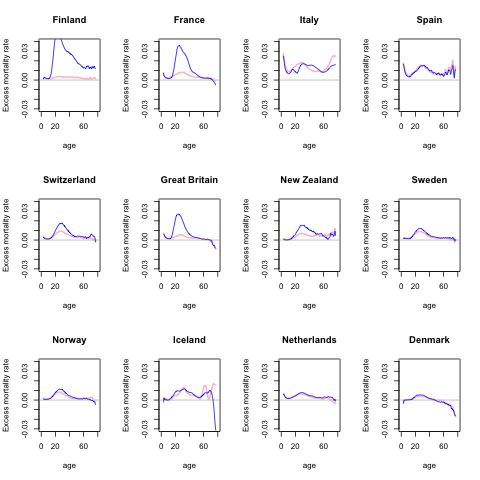When we consider the consequences of Covid-19, the Spanish Flu of 1918 is the pandemic that scares us the most. The Spanish Flu was deadly, particularly when it returned for a second time in the fall of 1918. The mortality age-pattern was highly unusual, with deaths in many countries peaking around age 28. (This earlier post discusses the more typical age pattern of influenza mortality observed in recent decades.)
A number of researchers have used the Spanish flu’s signature age pattern to try to unravel the mystery of what made the disease so dangerous for young adults. Alain Gagnon and colleagues used detailed historical registers in regions of Canada and the United States to argue that peak mortality corresponded to those exposed 28 years earlier to the “Russian flu.” Andrew Noymer and Michel Garenne (https://www.ncbi.nlm.nih.gov/pmc/articles/PMC2740912/) also use historical records to underline the role of co-incident tuberculosis in raising flu mortality, particularly for men.
In this post, I show how the Human Mortality Database can be used to estimate the age-pattern of the Spanish Flu. The HMD contains high-quality mortality estimates for 1918 and the surrounding years for a number of countries, but not the United States, which did not keep sufficient national statistics. There is no cause of death information in the HMD, but it is possible to estimate the excess mortality produced by the Spanish Flu by comparing the age-profile of mortality in 1918 to that of the year or years before and after. Estimates are available for a number of European countries as well as New Zealand.
My approach here will be to estimate excess mortality by age as the difference between the rates observed in 1918 and the years just before and just after. This is not an ideal approach since the world was in the midst of WWI before 1918, and mortality in the following years may have been lower than usual because the sickest members of populations had been killed by the flu. The results seem robust to the choice of comparison years, however, with a baseline consisting of the average age-specific mortality from 1910-13 and 1920-23 giving essentially the same results.
An example of the method
To illustrate, the figure below shows the age-specific mortality of Swedish females in 1917, 1918, and 1919 in the upper panel and the estimated excess mortality in 1918 in the lower panel. Swedish females seem a good group for the differencing approach, because they are not likely to have been much affected by World War I.

We can see that mortality rates were nearly the same before and after the flu in 1917 and 1919. The excess mortality attributable to the 1918 epidemic is extremely high for those aged about 15 to about age 40, peaking at 1 percent in the late 20s.
Excess Spanish Flu Mortality in 12 Countries
We are now ready to look at the historical data of all of the countries in the Human Mortality Database that have records for this time.

Comparing across countries, we see the same signature peak of deaths around age 28 that Gagnon and colleagues noted, which they attributed to early exposure to the Russian Flu of 1890. In some countries such as Italy, Spain, and perhaps New Zealand, we can see the (in)famous “W” pattern, with mortality peaks in infancy, early adulthood, and old age. However many countries – such as those in Scandinavia show only a single peak.
Sex Differences?
It is helpful to look at sex-differences in excess 1918 mortality in order to understand the differences between countries.

There is enormously higher mortality of males than females in some countries. France, Great Britain, and New Zealand all had soldiers in the trenches in the beginning of 1918 and brought them home later in the year by the time the second wave of the flu hit. (I don’t know why Finland males died at such high rates.)
The Spanish Flu was not necessarily more deadly for men than women. A number of populations show nearly identical mortality by sex. There is almost no differential by sex in Spain, Sweden, and Norway, although all suffered high flu mortality.
Summary
Although we use the Spanish Flu as our reference point for thinking about the impact Covid-19, the 1918 pandemic had what appears to be an exceptional age-pattern, with enormous mortality for men and women in their 20s. This is in marked contrast with the influenza-attributed mortality observed in recent years, which shows exponentially increasing mortality at older ages and very low relative risk for young adults.
The Spanish Flu occurred in the context of a unique set of circumstances including the geographic dispersion of sick soldiers returning from the front in World War I, the immunological history of those cohorts, and the endemic presence of tuberculosis
Undoubtedly, the Covid-19 pandemic will have its own set of unique circumstances that we have yet to discover. But the mortality reported to date (see the blog post by David Steinsaltz) seems much more consistent with higher risk for the oldest old found in modern influenza mortality statistics than it does with the enormous hazards faced by young adults in 1918.
Thanks! The interesting question of high mortality among young age clusters of men and women would also be interesting to integrate in a discussion of the responses to the Spanish Flu epidemic and its huge trauma. Such pronounced mortality rates in a young age group may have changed the responses to the disease.